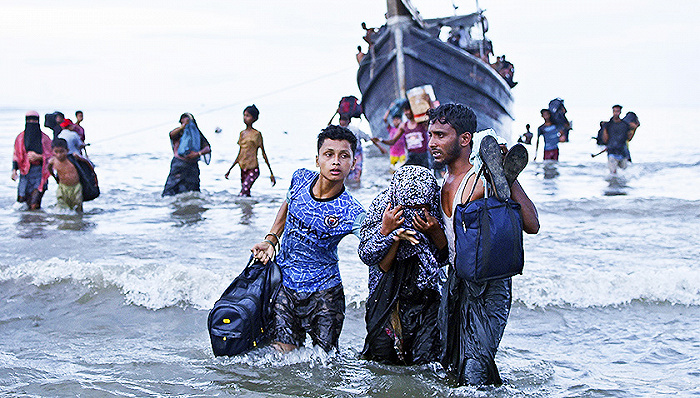
Behind every missing immigrant, there is a family waiting
“You can’t walk from here to a safe place! If you don’t call for help, you are in danger of life and death!” warned the English and Spanish signs. In the remote area of El Paso on the US Zhu border, the US Customs and Border Injury Service has installed dozens of “relief markers” resembling electric towers, allowing immigrants to press the red button to seek assistance.

But immigrants can be unwilling to seek assistance because they fear being driven out of nowhere. According to a report by Reuters in October 2023, whether stuffed into a stuffy truck trailer or fatigued and dehydrated by low temperatures, the number of deaths at the US Zhu border in 2022 is urging the United Nations immigration agency to consider the region the deadliest maritime immigration route in the world.
Since 2014, more than 4000 people worldwide have died or died each year during migration. The International Organization for Migration (IOM) recently released a statement analyzing data on the birth, death, or loss of immigrants over the past decade. According to the complaint, between 2014 and 2023, there were over 63000 immigrant deaths or losses. This number reached its peak in 2023- in 2023, it is known that over 8500 people died or were lost during the immigration process, which is the highest number recorded in the past decade and an increase of about 20% compared to 2022.
As in previous years, drowning is the primary cause of death during migration in 2023, accounting for 52% of all cases. The vast majority of drowning deaths occur in the Mediterranean, with a recorded total of 28000 people. However, thousands of people have also died while attempting to travel through Atlantic roads, the US Zhu border, the Gulf of Aden between the Horn of Africa and Yemen, and on roads from the Caribbean to the United States. According to a report by BBC in 2023, since 2014, the United Nations has cancelled over 17000 deaths and losses in the central Mediterranean, making it the most dangerous immigration crossing point in the world.
Among all the immigrants who drowned, over 23000 were lost and believed to have died at sea, many of whom were lost in large-scale maritime accidents, which also means their bodies have never been found.
On February 27, 2023, local time, in Steccato di Cutro, southern Italy, the wreckage of a failed immigration boat was washed ashore, not far from the coast, resulting in at least 94 deaths
However, in reality, these birth and death numbers are just the tip of the iceberg, as the lives and deaths of most immigrants from all over the world are not recorded. Moreover, over the past decade, more than two-thirds of the births and deaths recorded in the Lost Immigrant List (MMP) data are suspected to have incomplete information in their host countries. No matter where the birth and death occur, and whether the local government has the ability to develop appropriate identity verification methods, many people who die during migration still have unknown identities.
This also means that for each of them, there is a family facing the pain of losing loved ones, as well as the physiological, social, economic, and law enforcement effects brought about by unresolved losses. The families of lost immigrants are victims of this humanitarian catastrophe, but their role is unknown.
IOM’s Global Migration Data Analysis: A report issued by the Central Committee, the University of York, and the Metropolitan University of the UK, once focused on the impact of immigration loss on the families behind it. The report stated that this achievement exists in a strategic vacuum – there is little mutual assistance between institutions in different countries, there is a lack of effective investigation, and there is little effort to reach out to the families of lost employees.
The complaint states that domestic human rights law is applicable to situations where migrants are born, die, or lost within the country’s borders, and that according to domestic conventions, countries have the responsibility to identify the identity of the living and to disregard the right of the families of lost migrants. According to domestic humanitarian law, it is the responsibility of each country to cease effective investigation of all suspicious births and deaths, including the use of pace to identify bodies and obtain confirmation, and not to underestimate the lives and deaths of nationals and non nationals. However, researchers have found that not all of these responsibilities are recognized or adopted by unrelated countries in the vacuum evaluation of survival strategies in many countries.
Although those who witnessed the lives and deaths of shipwrecks knew that the lost could have been drowned, others openly questioned their families as still alive, thinking that their lost relatives were being detained in Europe or elsewhere, but had no choice but to approach them. In specific examples, immigrant families either watched their loved ones leave home and take boats, or – in many cases from Iraq and Syria – embarked on the path of migration with them and other family members. Most families do not receive news of lost employees, so their lives are uncertain and they do not know whether their loved ones are alive or not.
Studying and interpreting, the needs of family members should be clear, that is, to handle the results of lost employees with unknown luck. In the end, the study provided several initiatives, including involving family members in the process of conscription and identification, considering the management and return of survivors, providing social and physiological support for families, and supporting families to take a break.